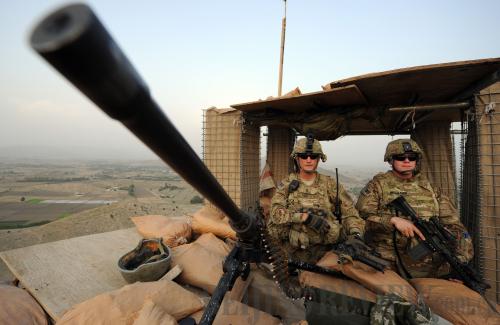|
 |
|
KEEPING ALERT: U.S. soldiers stand guard in a watch tower in east Afghanistan's Khost Province on June 21 (XINHUA/AFP) |
The changing international landscape is another important factor that has pushed Obama's decision to withdraw. First of all, terrorist threats to the United States have fallen. This May, U.S. special forces killed Al Qaeda leader Osama Bin Laden in Pakistan. After a decade of fighting its war on terror, the United States had finally won a major victory. This forced terrorists to move their bases from Afghanistan and Pakistan to Yemen and parts of North Africa. So the importance of the war in Afghanistan to U.S. national security has declined.
Though public protests in the Middle East and North Africa have led to social unrest and, to some extent, disrupted U.S. global strategies, they reduced the appeal of Al Qaeda and other terrorist organizations, and struck at terrorists' abilities to organize and recruit, to the advantage of U.S. anti-terrorist efforts.
Strategic intentions
The United States' overall strategy on Afghanistan and South Asia deserves even greater attention than the withdrawal plan. Since the terrorist attacks on September 11, 2001, the United States has sent 100,000 troops to Afghanistan. It is unlikely to give up its presence in South Asia, even as it begins decreasing its troop strength in Afghanistan.
The United States has stepped up efforts to forge an agreement on establishing strategic relations with Afghanistan, aiming to ensure its long-term and legal existence in the country. Since last year, it has invested billions of dollars in expanding military bases in Afghanistan. The United States obviously intends to maintain a military presence even after Afghan forces take over the brunt of security duties.
Moreover, the proposal of turning the "northern distribution network"—an important supply line for U.S. troops in Afghanistan—into a trade and energy corridor connecting Central Asia and South Asia has been under discussion for a long time. Given the United States' growing dependence on Afghanistan's neighbors in solving the Afghanistan issue, this proposal may be put into practice.
The U.S. plan to remove troops is not set in stone. It may be carried out as scheduled, or face many challenges that alter the timeframe.
For instance, the tide of the war may change. The Taliban has recently started its summer attacks, with the number of roadside bombings significantly increasing in recent weeks. The security situation in Afghanistan appears to be getting worse. The Taliban has also issued public statements saying it will increase attacks following the withdrawal of U.S. troops.
Negotiations between the United States and the Taliban are still up in the air. Although the United States has agreed to talks with the Taliban, its requirements may prevent those talks from achieving any results. The United States is also unwilling to accept one of the Taliban's main demands—that all foreign troops should withdraw from Afghanistan, which will preclude reconciliation of any kind.
Worse still, the relationship between American leaders and Afghan President Hamid Karzai is strained at best. The United States continues to hammer Karzai for corruption within his administration and his poor governing ability. Karzai has often spoken out against U.S. presence in his country. If this relationship continues to fester, it will undoubtedly have a detrimental impact on Afghanistan's future.
The author is an assistant research fellow with the Institute of American Studies at the China Institutes of Contemporary International Relations | 